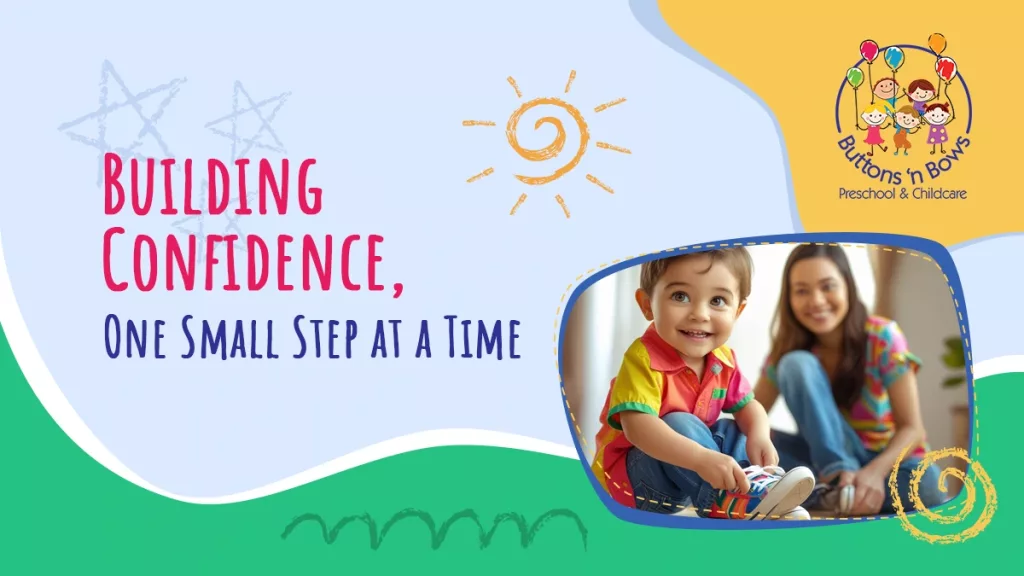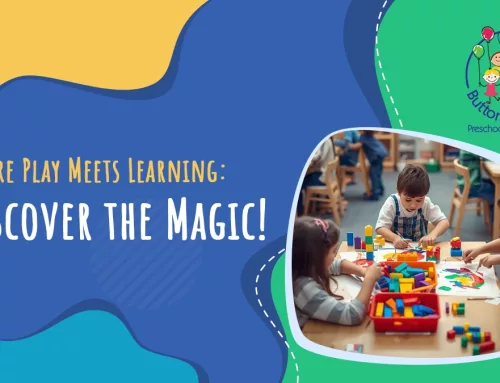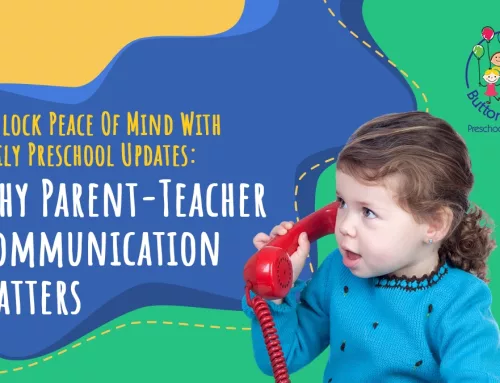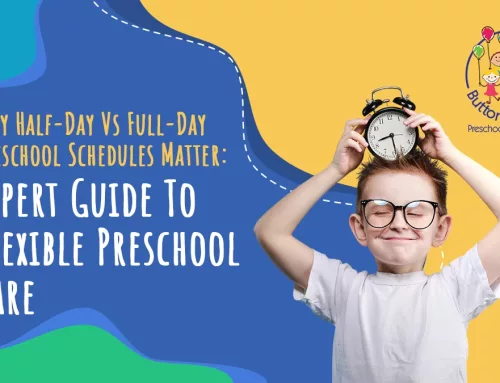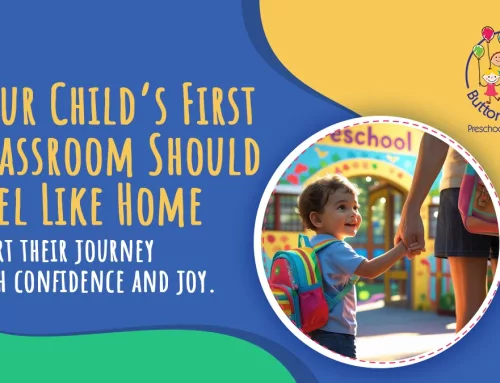Starting preschool marks a huge milestone for your child and for you. It’s the first step into a world of new friends, new routines, and new experiences. But as exciting as it is, it can also bring up a lot of questions. Is my child ready? Will they feel safe? What can I do to help?
At Buttons ‘n Bows Preschool & Childcare, we’ve walked alongside families for over 40 years as they navigate this big transition. We know that every child is unique, and so is every family’s journey into preschool. That’s why we’ve gathered these tried-and-true strategies to help you prepare your child with confidence, calm, and care.
So, where do you start?
The good news is that preparing your child for preschool doesn’t have to be complicated or stressful. It’s often the little things, such as daily routines, gentle conversations, and hands-on experiences, that make the biggest difference. By focusing on small, meaningful moments at home, you can help your child build the confidence and readiness they need to embrace this exciting new chapter.
Below, we’ve outlined proven strategies that support both emotional and practical readiness. These are simple, real-world ways to prepare your child for preschool with care, connection, and confidence.
How to Prepare Your Child For Preschool? Proven Strategies for Preschool Success
Readiness isn’t about perfection; it’s about giving your child the tools to feel safe, confident, and curious in a new environment. These proven strategies can help lay a strong foundation for a smooth and successful preschool experience.
Foster Emotional Confidence Through Familiarity
One of the best ways to reduce preschool anxiety is to build familiarity with what’s to come. Children find comfort in what they recognize, so introduce preschool gently and often. Read picture books that feature school settings, drive by the building together, or look at photos of the classroom and teachers if available.
At home, consider role-playing simple routines like waving goodbye, sitting for story time, or even packing a pretend lunchbox. The more a child understands what preschool looks and feels like, the more emotionally prepared they’ll be to step into it.
Encourage Age-Appropriate Independence
Preschoolers don’t need to do everything themselves, but helping them feel capable in small ways goes a long way.
Try practicing:
- Putting on shoes and coats
- Washing hands before meals
- Carrying a backpack
- Tidying up toys
These simple tasks translate directly to the preschool day, where teachers encourage children to take responsibility for their belongings, follow group routines, and navigate transitions with minimal help. Start slowly and celebrate progress—it’s less about perfection and more about progress and pride.
Practice Predictable Daily Routines
Young children thrive in environments with consistent routines. A predictable rhythm helps them know what to expect and when, reducing stress and boosting confidence, especially in unfamiliar settings like preschool.
Start by setting up a straightforward, consistent routine at home that feels a bit like a school day: waking up at the same time, having meals at regular times, and sticking to a basic morning routine. Even doing a fun practice run of “getting ready for school” can help kids feel more confident and ready for the big day. For more ideas on creating healthy routines, check out this preschool morning routine guide by Zero to Three—a trusted early childhood development organization.
Support Social and Communication Skills
Preschool is a social experience, and while no child is expected to be a social butterfly from day one, basic social and communication skills can go a long way. You don’t need to pressure your child to be the most outgoing in the room. But preschool readiness is supported by:
- Sharing toys during playdates
- Taking turns in simple games
- Expressing needs and emotions with words (“I need help,” “I’m feeling shy”)
You can model these behaviors at home by playing simple games that require patience and cooperation, narrating feelings out loud (“You’re feeling frustrated because the block tower fell”), or encouraging your child to use polite words when making requests. These interactions strengthen the foundation for positive relationships in the classroom.
Build Resilience Through Gentle Separation Practice
Separation from a caregiver is one of the most common challenges for preschoolers, but with a bit of practice and a lot of reassurance, it can become a manageable part of their day. Start with short separations—like leaving your child with a trusted friend or family member for an hour, and gradually increase the time apart.
When it’s time for drop-off, keep your goodbye calm and confident. Avoid slipping away unnoticed or dragging out the farewell; both can create more anxiety. A predictable goodbye routine (like a hug, a wave, and a “See you after snack time!”) helps your child build the trust that you will always come back.
First Day of Preschool Tips Every Parent Should Know
No matter how prepared you feel, the first day of preschool can stir up big emotions for both you and your child. It’s completely normal to feel excited, anxious, proud, and even a little tearful all at once. Many parents worry: Will they be okay without me? What if they cry? What if I cry? You’re not alone in those thoughts.
The good news? A little preparation can go a long way in making that first drop-off feel smoother, more predictable, and more positive for everyone involved. Here are some helpful, realistic tips to guide you through that big first morning.
Start the Day with Calm and Clarity
Try to keep the morning as relaxed as possible. Give yourself extra time so you’re not rushing out the door. Set clothes and backpacks out the night before, and build in time for a peaceful breakfast together.
Children take their emotional cues from you—if you’re calm and confident, they’re more likely to feel grounded, too.
Label Everything (And We Mean Everything!)
From lunchboxes to loveys to extra clothes, make sure every item your child brings is labeled with their name. It’s not just helpful for the teachers—it gives your child a sense of ownership and familiarity with their belongings.
Pack a Comfort Item
If your child has a favorite stuffed animal, small blanket, or even a family photo, check if they’re allowed to bring it along. A comfort object can be a powerful emotional anchor throughout the day.
Even if they don’t need it, knowing it’s nearby can be incredibly reassuring.
Keep Goodbyes Short, Sweet, and Predictable
This is often the most challenging part. You may feel tempted to linger, but long goodbyes can increase anxiety for both of you. Instead, establish a short and loving farewell routine: a hug, a kiss, and a cheerful “I’ll see you after snack time!”
Avoid sneaking out, even if your child is distracted. A predictable goodbye builds trust and helps your child learn that departures are temporary—and that you’ll always return.
Plan a Light Afternoon
The first day can be emotionally and physically draining for young children, even if it goes really well. Try not to overschedule the afternoon. Instead, leave space for rest, cuddles, or simple playtime at home.
Ask open-ended questions like “What did you do after snack?” or “What was the funniest part of your day?” to gently encourage conversation without pressure.
Give Yourself Grace
And lastly, don’t forget to care for yourself, too. Whether you’re heading back to work or spending the morning wondering how they’re doing, know that your emotions are valid. This is a big step, and you’ve done the hard, beautiful work of preparing your child for it.
You’re not alone in this, and you’re doing better than you think.
Transitioning to Preschool: How to Support Your Child in the First Few Weeks
The first day is just the beginning. For many children, transitioning to preschool is a gradual process that unfolds over several days or even weeks. During this time, emotions may rise and fall—your child might be excited one morning and hesitant the next. That’s completely normal.
What matters most is how you support them during this adjustment period. Here are a few thoughtful ways to ease the transition and help your child build lasting confidence in their new preschool routine.
Expect Ups and Downs—and Stay Consistent
It’s common for children to show a “honeymoon” phase during the first few days, only to hit a wave of separation anxiety later in the week. This doesn’t mean something’s wrong; it’s simply their way of processing change.
Stick to your routines, continue with your short and loving goodbyes, and trust the process. Your steady presence—even at drop-off—offers the reassurance they need to settle in.
Stay Curious and Connected Without Pressure
Rather than asking “Did you have fun?” or “Were you good today?” try using open-ended, low-pressure questions that invite sharing:
- “What was the silliest thing that happened today?”
- “Who did you sit next to during lunch?”
- “What book did your teacher read?”
Some children will talk endlessly; others may need time to decompress. Either way is okay. Your interest builds emotional safety, even in silence.
Partner with Teachers—They’re on Your Team
Preschool teachers are a fantastic resource during this time. Don’t hesitate to ask how your child is adjusting or to share helpful insights from home (“They’re more relaxed after a hug and a water break”). The more consistent the approach between home and school, the smoother the transition.
If your child is struggling, working together on a small action plan—like a comfort object at naptime or a goodbye routine that includes the teacher—can make a big difference.
Celebrate Progress, Not Perfection
Maybe they went the whole day without tears. Perhaps they joined a new group activity or said goodbye without clinging. Celebrate these moments!
Positive reinforcement doesn’t have to be a sticker chart—it can be a high-five, a proud smile, or a cozy moment of connection at bedtime. Acknowledging growth builds self-esteem and motivates your child to keep trying, even when it feels tough.
Trust the Process—And Your Child
Transitions take time, and there’s no single right way to move through them. Some kids jump in with both feet; others need a little extra hand-holding. What matters most is that your child feels seen, supported, and loved.
With patience, consistency, and open communication, this new chapter can become a joyful one for both of you.
Buttons’ n Bows: Where Every Child Is Welcomed, Known, and Encouraged to Grow
Preparing for preschool is about more than routines and readiness; it’s about finding a place where your child can feel truly seen, supported, and celebrated. A place where you, as a parent, feel confident in the care your child is receiving.
At Buttons’ n Bows Preschool & Childcare, our play-based curriculum empowers children to learn through curiosity, creativity, and purposeful discovery—whether they’re building with blocks, telling stories with puppets, or digging into sensory bins. We believe that when kids learn by doing, they thrive, as do families.
We also know the importance of staying connected. That’s why we use the Procare communication system, so parents receive daily photos, classroom updates, and even diaper or potty alerts—keeping you in the loop and your mind at ease.
Our experienced team works closely with every family to tailor learning and care to each child’s rhythm. We see every little milestone: the first time they zip their jacket, the first time they join a group. And we celebrate them all—big or small.
Feeling ready to let your child’s preschool adventure begin, with trust and joy?
We’re here when you are. Schedule a visit, ask questions, or simply get to know us better. When you’re ready to step into a community that loves learning as much as they love your child, we’ll be waiting with open arms.




